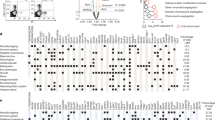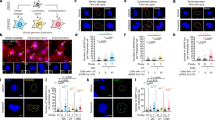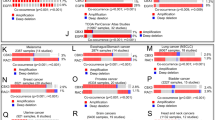Abstract
The Cdx2 gene is one of three murine homologues of the Drosophila homeobox gene caudal. Mice heterozygous for a null mutation in Cdx2 exhibit a variable phenotype including tail abnormalities, stunted growth and a homeotic shift of vertebrae. Most strikingly, however, 90% of heterozygous mice were reported to develop multiple intestinal adenomatous polyps, most notably in the proximal colon (). These observations led us to propose that mutation of CDX2 may be involved in the genesis of some human colorectal tumours. A survey of DNA from 85 colorectal tumours revealed that one with extensive microsatellite instability (RER+ phenotype) has mutations in both alleles of CDX2. Both mutations occur in coding regions which contain repetitive elements and are consistent with those found in RER+ tumours.
This is a preview of subscription content, access via your institution
Access options
Subscribe to this journal
Receive 50 print issues and online access
$259.00 per year
only $5.18 per issue
Buy this article
- Purchase on Springer Link
- Instant access to full article PDF
Prices may be subject to local taxes which are calculated during checkout
Similar content being viewed by others
Author information
Authors and Affiliations
Rights and permissions
About this article
Cite this article
Wicking, C., Simms, L., Evans, T. et al. CDX2, a human homologue of Drosophila caudal, is mutated in both alleles in a replication error positive colorectal cancer. Oncogene 17, 657–659 (1998). https://doi.org/10.1038/sj.onc.1201971
Received:
Revised:
Accepted:
Published:
Issue Date:
DOI: https://doi.org/10.1038/sj.onc.1201971
Keywords
This article is cited by
-
Expression of MUC2, MUC5AC, MUC5B, and MUC6 mucins in colorectal cancers and their association with the CpG island methylator phenotype
Modern Pathology (2013)
-
Polycomb group proteins: navigators of lineage pathways led astray in cancer
Nature Reviews Cancer (2009)
-
Linking the ovarian cancer transcriptome and immunome
BMC Systems Biology (2008)
-
CDX2 has tumorigenic potential in the human colon cancer cell lines LOVO and SW48
Oncogene (2006)
-
Accumulation Profile of Frameshift Mutations During Development and Progression of Colorectal Cancer From Patients With Hereditary Nonpolyposis Colorectal Cancer
Diseases of the Colon & Rectum (2006)



